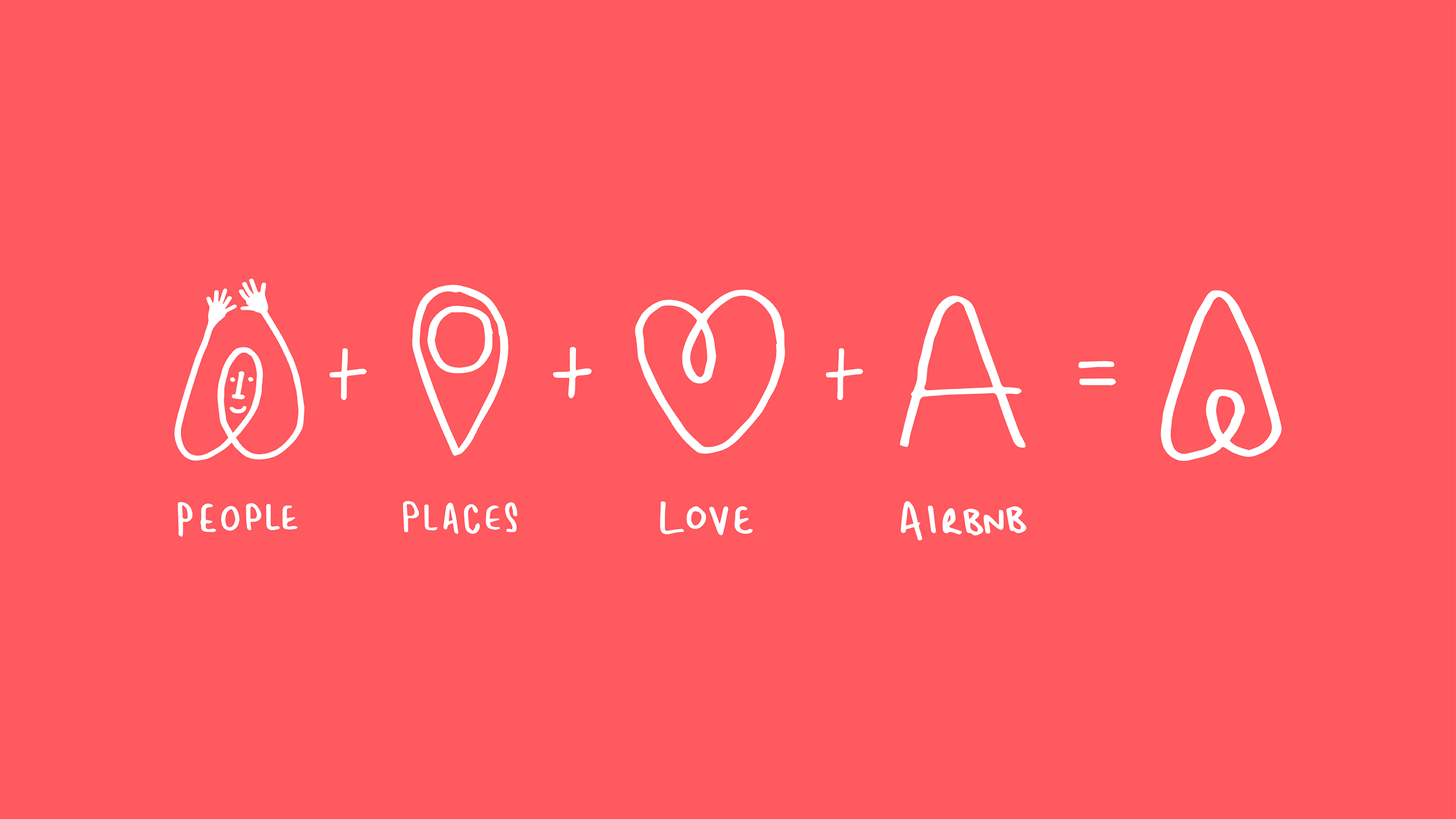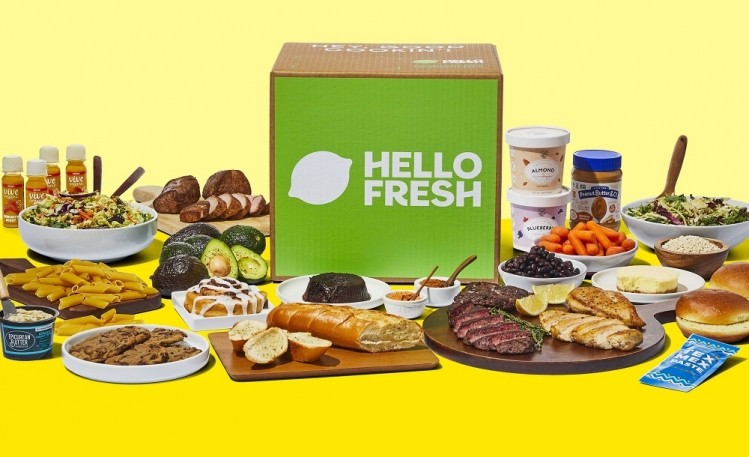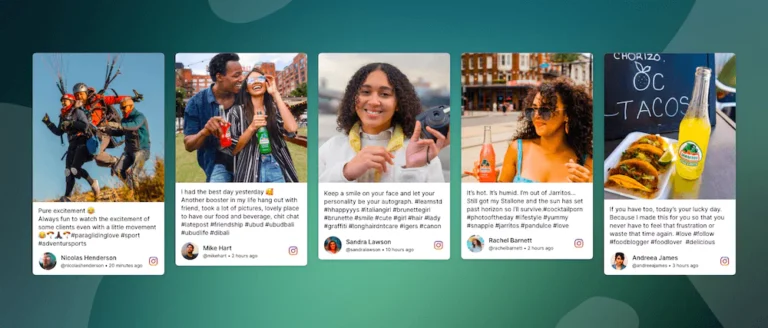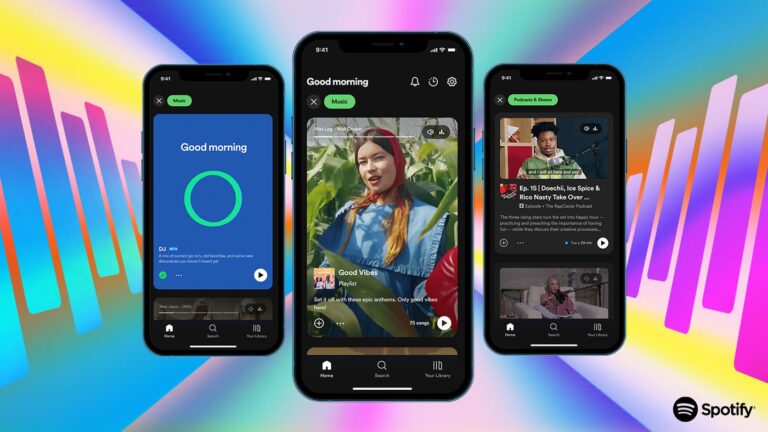
Imagine scrolling through social media, bombarded with polished ads until a post stops you dead in your tracks. It’s not a flashy commercial, but a down-to-earth UGC example – a customer’s funny review or a breathtaking photo showcasing a product in action. It feels genuine, and relatable, and instantly captures your attention. That’s the power of User-Generated Content.
UGC examples are the content of everyday people – your customers, fans, and brand champions. They’re the authentic voices that cut through the marketing noise and resonate deeply with audiences. In today’s digital landscape, where trust is king, UGC examples have become an essential tool for brands to connect, engage, and build lasting relationships.
Think about it: would you trust a generic company slogan or a real person raving about their experience in a compelling UGC example? In a content-saturated world, UGC examples stand out as the voice of authority that truly matters – the voice of the people.
Top UGC Examples That Rank on Google
UGC isn’t just a feel-good marketing tactic; it’s a powerful tool that can propel your brand to the top of search results. Here, we’ll delve into six stellar UGC examples that are winning the Google game, analyzing what makes them stand out and how they seamlessly integrate SEO best practices.
1. Airbnb: Unveiling the World Through Unique Stays

Airbnb thrives on showcasing unique travel experiences. Their platform is brimming with user-generated photos and reviews that highlight the charm and character of their listings.
What Makes Them Shine: Airbnb lets travelers become storytellers. User-generated photos and reviews showcase the individuality and charm of each listing, far exceeding the sterile descriptions of traditional hotels. This fosters a sense of discovery and authenticity, enticing potential guests to experience unique and unforgettable stays.
User-generated content on Airbnb plays a double role in SEO. First, location-specific details in reviews and captions (“cozy cabin getaway in the Smoky Mountains”) can attract local and regional searches. Secondly, unique property features mentioned in reviews (“private rooftop terrace with city views”) can improve the ranking of specific listings for relevant keywords, making them more discoverable by potential guests searching for those amenities.
2. Sephora: Beauty Through the Eyes of Real People

Sephora understands the power of relatable beauty. Their “Beauty Insider Community” thrives on UGC examples like makeup tutorials, product reviews, and before-and-after transformations.
What Makes Them Shine: Sephora empowers customers to become beauty experts. Their platform allows users to rate and review products, fostering trust and encouraging others to try them. This constant influx of user-generated reviews provides valuable content for potential buyers, showcasing real results and increasing brand credibility.
Reviews on the Sephora website often include specific product names and benefits (“Fenty Beauty foundation is full coverage and long-lasting”). These reviews, acting as mini SEO magnets, attract users searching for those exact keywords, propelling Sephora’s product pages to the top of search results.
3. Wayfair: Transforming Homes with Inspiration

Wayfair isn’t just about selling furniture; it’s about inspiring home decor dreams. Their “Hashtag Home” campaign encourages customers to share photos of their Wayfair-furnished spaces, creating a virtual showroom of real-life style.
What Makes Them Shine: Wayfair taps into the power of visual UGC. User-generated photos showcase furniture in actual homes, providing a more relatable and aspirational experience for potential buyers. This fosters a sense of community and helps users visualize how Wayfair products can elevate their own spaces.
Customers often tag specific Wayfair products in their photos, linking directly back to the product page. This creates a direct path from inspiring UGC example to product purchase, all while naturally incorporating relevant product names into searchable content.
4. Starbucks: Brewing Connections, One Cup at a Time

Starbucks understands the power of fostering a “third place” experience. Their “#MyStarbucksMoment” campaign invites customers to share their coffee shop experiences through photos and stories.
What Makes Them Shine: Starbucks fosters a sense of community and belonging through UGC. Customers share their favorite drinks, cozy reading nooks, or friendly barista interactions, creating a warm and inviting online atmosphere. This emotional connection strengthens brand loyalty and encourages repeat customers.
While not as keyword-driven as other examples, “#MyStarbucksMoment” can still contribute to SEO. Locations mentioned in posts might attract local searches, and user-generated content discussing specific drinks (“pumpkin spice latte”) can pique the interest of potential customers searching for those seasonal offerings.
5. HelloFresh: Making Mealtime an Adventure with User-Generated Recipes

HelloFresh delivers fresh ingredients and delicious recipes right to your door. However, they take things a step further by encouraging users to get creative in the kitchen and share their recipe tweaks through the #HelloFreshHack hashtag.
What Makes Them Shine: HelloFresh empowers customers to personalize their meal kits. By showcasing user-generated recipe modifications, they demonstrate the versatility of their ingredients and inspire others to try new flavor combinations. This fosters customer engagement and keeps things fresh (pun intended!).
#HelloFreshHack examples often include specific recipe names and ingredient substitutions. These details act as mini SEO boosters, attracting users searching for variations on existing HelloFresh recipes, potentially leading them to the company’s website for more inspiration.
6. GoPro: Capturing the World, One Adventure at a Time

GoPro practically wrote the book on leveraging UGC. Their entire brand identity revolves around user-generated content – breathtaking action shots, awe-inspiring travel vlogs, and heart-stopping POV footage captured on their cameras.
What Makes Them Shine: GoPro doesn’t just encourage UGC; they actively cultivate it. Their “#GoPro” hashtag is a global phenomenon, with millions of users sharing their experiences. This constant stream of fresh, user-generated content keeps GoPro’s website brimming with relevant keywords like “action camera,” “travel photography,” and “adventure sports,” boosting their SEO power.
Every GoPro #UGC example becomes a potential SEO powerhouse. Users often include location-specific keywords (“surfing in Bali”) or activity-related phrases (“mountain biking downhill”), naturally weaving these keywords into the content. This not only increases GoPro’s website traffic but also positions them for relevant searches.
Why Google Loves UGC

Freshness is King: Google prioritizes websites with fresh, up-to-date content. UGC by its very nature is constantly evolving, with new reviews, photos, and comments being added regularly. This constant influx of fresh content keeps your website dynamic and signals to Google that it’s a valuable resource for searchers.
Relevance Reigns Supreme: Google wants to deliver the most relevant results to user queries. UGC, particularly reviews and comments that discuss specific keywords related to your products or services, directly contributes to your website’s topical relevance. This increases the chances of your website appearing in search results for those keywords.
This article dives into why Google loves UGC, but its benefits extend far beyond established businesses. For those starting small and nimble, the exciting world of micro-SaaS (software-as-a-service) offers a unique chance to leverage UGC’s power. Curious? Check out our guide to innovative Micro-SaaS ideas – you might discover the perfect platform to harness UGC and catapult your business forward!
The SEO Powerhouse: UGC doesn’t just improve website freshness and relevance; it directly impacts your SEO. Positive reviews and comments often contain long-tail keywords – specific phrases users search for. By incorporating these keywords naturally within UGC, your website becomes more discoverable in search engine results pages, potentially boosting your ranking for relevant searches.
Think of UGC as a constant stream of user-generated SEO magic, keeping your website fresh, relevant, and keyword-rich – all factors Google highly values.
The Power of UGC in Digital Marketing
UGC isn’t just a passing trend; it’s a game-changer in digital marketing. Here’s why:
Building Trust: Consumers today are bombarded with advertising, making them increasingly skeptical of traditional marketing messages. A study by Stackla found that 86% of consumers say authenticity is a key factor in deciding which brands they like and support. UGC examples, by their very nature, are seen as genuine and unbiased, fostering trust and credibility for your brand.
This deep dive explores the power of user-generated content (UGC) in digital marketing, but its influence stretches far beyond! Craving fresh content and a more interactive experience? Look no further than the world of music streaming. Platforms like Spotify alternative are hotbeds of UGC, where user-generated playlists and artist communities are shaking things up. Dive in and discover a vibrant scene waiting to be explored – you might be surprised by the impact UGC is having on the music industry!
Boosting Engagement: UGC sparks conversations and encourages interaction. According to Social bakers, content with UGC receives 28% higher engagement than brand-generated content alone. Imagine a customer posting a creative recipe using your product – it ignites user-generated discussions, shares, and inspires others to try it themselves, creating a vibrant online community around your brand.
These statistics highlight the undeniable impact of UGC on brand trust and customer engagement, making it a powerful tool for any digital marketing strategy.
How to Create UGC That Google Adores.
Now that you’ve witnessed the power of stellar UGC examples, let’s dive into how you can cultivate a treasure trove of your own. Here are some actionable tips to encourage high-quality, SEO-friendly UGC that Google will love:
Host UGC Contests: Fuel creativity with themed contests. Encourage users to submit photos, videos, or reviews using a specific hashtag (think #MyBrandExperience). This not only generates a surge of UGC examples but also leverages the power of the contest hashtag to boost discoverability.
Crafting UGC that Google loves can feel overwhelming, especially if you’re new to marketing automation tools. But fear not! If you’re already familiar with Zapier, there’s a whole world of powerful alternatives waiting to be explored. Dive into our guide to the best Zapier alternatives – you might discover the perfect platform to streamline your UGC creation process and impress Google!
Run User-Generated Takeovers: Hand over the reins to your most enthusiastic customers! Let them curate a section of your website or social media feed with their UGC examples. This fosters a sense of community and authenticity, while showcasing the versatility and value of your brand.
Spark Conversations with Prompts: Don’t be afraid to guide the conversation. Pose engaging questions or challenges that encourage users to share their experiences. For example, ask customers to share their favorite recipe hacks using your product (think #BrandNameKitchenHacks) or prompt travelers to document their adventures with your travel service (think #ExploreWithBrandName).
Prioritize Authenticity: Remember, the magic of UGC lies in its genuine voice. Don’t try to manufacture content. Encourage users to share their honest experiences, both positive and negative. Addressing constructive criticism demonstrates transparency and builds trust with potential customers.
SEO Optimization with a Natural Touch: While SEO is important, keyword stuffing is a turn-off. Encourage users to naturally incorporate relevant keywords into their UGC examples. Run contests or challenges with specific themes to subtly guide keyword usage without sacrificing authenticity.
Comply with Google’s Guidelines: Ensure all UGC examples adhere to Google’s Webmaster Guidelines. Discourage spammy content or misleading information. Moderate comments to maintain a positive and brand-safe environment for your audience.
By following these tips, you’ll cultivate a treasure trove of valuable UGC examples that resonate with audiences and help your brand climb the Google search ladder. Remember, fostering a community where users feel empowered to share their voices is key to unlocking the true power of UGC.
Conclusion:
UGC isn’t just a trend; it’s a digital marketing powerhouse. We’ve seen how UGC examples build trust, boost engagement, and fuel SEO. From GoPro’s action adventures to HelloFresh’s recipe hacks, UGC captivates audiences and propels brands to the top.
The key? Authenticity. Foster real, relatable UGC that sparks conversations and builds a thriving brand community. Implement the tips and strategies we discussed to cultivate a treasure trove of Google-friendly UGC examples. This content won’t just elevate your brand; it will connect with your audience on a deeper level. If you love this then read our more blogs.
Thank You – Rohit Sharma
Edit Like a Pro: Best AI Tool For Video Editing in 2024
Killer UGC Examples That Google Loves
Designing Rules? Screw It! Become a Rock Star Designer (But Seriously, Here’s How)
Sony PS5 Pro Experience Gaming Like Never Before.
Spotify Alternative to Spice Up Your Music Streaming Experience
VideoPrism, The Future of Video Analysis with Google’s AI Tool.
Top 5 Free Google Generative AI Courses
Best Chat Gpt alternatives free 2024
iPhone 16: Everything you should Know
Samsung Galaxy Ring vs Oura Ring – Which Is Best?
Top 10 AI Animation Tools for 2024
What is Sora AI? How it Works, Use Cases & More
Future of electric vehicle in India 2024
7 Best Zapier Alternatives & Competitors in 2024
Best Video Translator Tool to Translate Video Online for Free
The top 10 new alternative to chatgpt for developers in 2024
What is Krutrim AI and Why You Should Care About It.
Gemini vs ChatGPT: Who is Best and What’s the Best Difference?
Why is personal branding important in 2024 ?
5 Ways Your AI Written Text is Obvious, and Here’s How to Fix It



